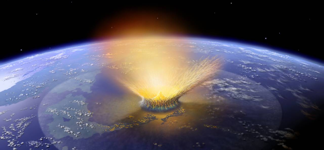
Asteroid impacting Earth (NASA)
NASA: There is No Truth Behind Asteroid Online Rumor
The internet has been abuzz with a now viral rumor that life on Earth will be wiped out by a massive asteroid strike some time near the end of September.
Numerous recent blogs and web postings are erroneously claiming that an asteroid will impact Earth, sometime between Sept. 15 and 28, 2015. On one of those dates, as rumors go, there will be an impact — “evidently” near Puerto Rico — causing wanton destruction to the Atlantic and Gulf coasts of the United States and Mexico, as well as Central and South America.
The folks at NASA beg to differ, and have had to come out with a statement they hope will diffuse this rumor of doom.
“There is no scientific basis — not one shred of evidence — that an asteroid or any other celestial object will impact Earth on those dates,” said Paul Chodas, manager of NASA’s Near-Earth Object office at the Jet Propulsion Laboratory in Pasadena, California in a NASA press release.
The NASA office that keeps watch on potentially dangerous incoming objects says that they not only haven’t seen any asteroids or comets that would smack into the Earth anytime in the foreseeable future but all known Potentially Hazardous Asteroids have less than a 0.01% chance of colliding with our planet within the next 100 years.

Children in daycare (meddygarnet/creative commons)
Study: Daycare Has Little Effect on a Child’s Aggression
A new study recently published in Psychological Science may bring a measure of relief to those who send their children to daycare.
Researchers followed a thousand Norwegian kids who were sent to childcare, and found that the amount of time the children spent at daycare were no more likely to exhibit aggressive behavior than children who were raised at home.
The researchers plan next to study the positive effects of day care on children’s learning and language development.
Astronomers Spot Spectacular Display of Celestial Fireworks
Astronomers from the University of Manchester (England) and the University of Hong Kong say that a collision between two small nearby galaxies they’ve spotted is producing an incredibly colorful celestial fireworks display.
The researchers say that this so-called “bull’s eye collision” between the two galaxies of similar mass is taking place about 30 million light years away from Earth near the Milky Way.
A bull’s eye collision has been described as one galaxy blasting through the center or bull’s eye of another galaxy like a cannon shot.
The incredible display, which the astronomers say resembles a firework called a “Catherine Wheel” or pinwheel, is made possible after collision shockwaves squeeze supplies of gas from each of the galaxies. This process sparks the creation of new stars which produces a cosmic ring of powerful emissions that illuminates the now combined star system.
Although collisions help a number of galaxies, the astronomers say that it is quite rare to observe one as its taking place. The “bull’s-eye” galactic collision they discovered is even rarer to catch while in progress.
Psychopaths Less Likely to “Catch Yawns”
If you see someone yawn it’s most likely that you’ll yawn too. This phenomenon is often referred to a “contagious yawning” and has been associated with feelings of empathy and bonding.
Now scientists at Baylor University in Texas have found that people with psychopathic traits are less likely to be affected by contagious yawning.
Those with psychopathic traits aren’t as empathetic, unable to feel guilt or remorse and tend to be quite cunning and manipulative without a regard for others.

























It might be possible to recycle hydrocarbon-rich solid waste through destructive distillation to produce synthetic crude oil. This might have some potential in conserving resources.
I was interviewing for a job at Kennedy Space Center in February 2013 where I was asked to write a news article about the asteroid that is heading near Earth. I was given facts where I then had 30 minutes to write a press release. The below is my written press release and how I would market it through the various media outlets. I sent this through email so I still have the time and date stamp showing that this was sent on February 5th 2013, which was (from what I have seen) well before talks of the asteroid ever surfaced. After many interviewees submitted their press releases the job mysteriously went away.
NASA Trains to Save the World
For the first time since July 2011 NASA is sending a manned aircraft into space. NASA will be using a new space launch system where the crew will be riding in the capsule of an Orion rocket. Their mission is to land on a large asteroid roughly the size of Rhode Island that will pass by the Earth in an estimated year and a half. Although the asteroid is about 1 million miles away from the Earth (the Moon is 238,900 miles) it poses no threat to humanity. The goal of NASA is to not only continue their goal of exploration but to have experience and a plan in place if an asteroid of this magnitude ever does post a threat to our planet. (Get the latest information regarding this mission by going to http://www.kennedyspacecenter.com/?utm_source=bing&utm_medium=cpc&utm_term=kennedy%20space%20center%20fl&utm_content=1707820897&utm_campaign=Geo+Brand+FL )
To market this I would have the video side of the house get B-Roll of the new space launch system and upload it to DIVIDS. I would then direct every major media outlet (CNN, Fox News ect…) to the DIVIDS link so that they could use the B-Roll for their own productions. I would also have the video team put a product together and put it on the main website and facebook. The written piece would go out on Twitter and the major internet media news sites. (Yahoo News, ect…)I would hold media days throughout the mission progress.
The article says: ‘The researchers say that this so-called “bull’s eye collision” between the two galaxies of similar mass is taking place about 30 light years away from Earth near the Milky Way.’ Since the Milky Way is estimated to be 100,000 to 120,000 light years across, I’m guessing that the reported distance to this collision of galaxies as being 30 LY is incorrect. Would you please double check that figure?
Hello Meg,
Thanks so much for checking in. My posting listed 30 light years away was a typo – its 30 million light years or about 10 megaparsecs away. The error has been corrected.
Thanks again!
Rick Pantaleo